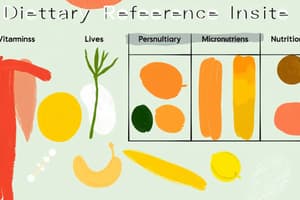Podcast
Questions and Answers
Which lipoprotein is considered 'good' and is responsible for removing excess cholesterol from the blood?
Which lipoprotein is considered 'good' and is responsible for removing excess cholesterol from the blood?
The Recommended Dietary Allowance (RDA) for protein is 0.8g per kilogram of body weight.
The Recommended Dietary Allowance (RDA) for protein is 0.8g per kilogram of body weight.
True (A)
What is the primary storage form of carbohydrates in the liver and muscles?
What is the primary storage form of carbohydrates in the liver and muscles?
glycogen
A deficiency in vitamin B1, also known as thiamine, can result in the disease called ____.
A deficiency in vitamin B1, also known as thiamine, can result in the disease called ____.
Signup and view all the answers
Match the following vitamins with their primary function:
Match the following vitamins with their primary function:
Signup and view all the answers
Which of the following is a symptom of vitamin A deficiency?
Which of the following is a symptom of vitamin A deficiency?
Signup and view all the answers
Water-soluble vitamins, such as vitamin C, can accumulate in the body and cause toxicity.
Water-soluble vitamins, such as vitamin C, can accumulate in the body and cause toxicity.
Signup and view all the answers
The Adequate Intake (AI) for fiber is how many grams per day for males?
The Adequate Intake (AI) for fiber is how many grams per day for males?
Signup and view all the answers
What condition can occur due to a deficiency in dietary protein?
What condition can occur due to a deficiency in dietary protein?
Signup and view all the answers
Vitamin B9 or folate helps with the synthesis of DNA, as well as the process called _____.
Vitamin B9 or folate helps with the synthesis of DNA, as well as the process called _____.
Signup and view all the answers
Which electrolyte is primarily responsible for maintaining fluid volume inside cells?
Which electrolyte is primarily responsible for maintaining fluid volume inside cells?
Signup and view all the answers
Excess sodium can lead to muscle cramping and memory loss.
Excess sodium can lead to muscle cramping and memory loss.
Signup and view all the answers
What is the normal range for serum potassium levels in mEq/L?
What is the normal range for serum potassium levels in mEq/L?
Signup and view all the answers
Magnesium is important for ___ formation and smooth muscle relaxation.
Magnesium is important for ___ formation and smooth muscle relaxation.
Signup and view all the answers
Match the following electrolytes with their known functions:
Match the following electrolytes with their known functions:
Signup and view all the answers
What could be a symptom of magnesium deficiency?
What could be a symptom of magnesium deficiency?
Signup and view all the answers
A common food source of calcium is bananas.
A common food source of calcium is bananas.
Signup and view all the answers
Name one of the causes of calcium imbalance.
Name one of the causes of calcium imbalance.
Signup and view all the answers
Water intake daily should be approximately _____ liters.
Water intake daily should be approximately _____ liters.
Signup and view all the answers
What is the primary source of energy in the body?
What is the primary source of energy in the body?
Signup and view all the answers
Which term refers to the highest level of nutrient intake that is unlikely to pose risks of adverse health effects?
Which term refers to the highest level of nutrient intake that is unlikely to pose risks of adverse health effects?
Signup and view all the answers
The average DRI for carbohydrates is 150g per day.
The average DRI for carbohydrates is 150g per day.
Signup and view all the answers
What are the three primary types of lipids?
What are the three primary types of lipids?
Signup and view all the answers
The RDA for fiber is _____ grams per day for females.
The RDA for fiber is _____ grams per day for females.
Signup and view all the answers
Match the following macronutrients with their main function:
Match the following macronutrients with their main function:
Signup and view all the answers
What is the recommended daily intake of protein for adults based on kg of body weight?
What is the recommended daily intake of protein for adults based on kg of body weight?
Signup and view all the answers
All types of fats are beneficial to the body.
All types of fats are beneficial to the body.
Signup and view all the answers
What percentage of total calories should come from fats according to AMDR?
What percentage of total calories should come from fats according to AMDR?
Signup and view all the answers
The two types of carbohydrates are _____ and _____ saccharides.
The two types of carbohydrates are _____ and _____ saccharides.
Signup and view all the answers
Which of the following is classified as a disaccharide?
Which of the following is classified as a disaccharide?
Signup and view all the answers
What is the primary role of High-Density Lipoproteins (HDL)?
What is the primary role of High-Density Lipoproteins (HDL)?
Signup and view all the answers
The Daily Recommended Intake (DRI) for carbohydrates is 130g per day.
The Daily Recommended Intake (DRI) for carbohydrates is 130g per day.
Signup and view all the answers
What condition is characterized by insufficient protein intake, resulting in edema?
What condition is characterized by insufficient protein intake, resulting in edema?
Signup and view all the answers
The primary storage form of carbohydrates in the liver and muscles is _____.
The primary storage form of carbohydrates in the liver and muscles is _____.
Signup and view all the answers
Which of the following foods is a good source of Vitamin C?
Which of the following foods is a good source of Vitamin C?
Signup and view all the answers
Fat-soluble vitamins can accumulate in the body and may lead to toxicity.
Fat-soluble vitamins can accumulate in the body and may lead to toxicity.
Signup and view all the answers
What is the function of Vitamin B6 (Pyridoxine)?
What is the function of Vitamin B6 (Pyridoxine)?
Signup and view all the answers
Excessive intake of Vitamin D can lead to symptoms of hypercalcemia, such as excessive _____ and bone pain.
Excessive intake of Vitamin D can lead to symptoms of hypercalcemia, such as excessive _____ and bone pain.
Signup and view all the answers
What is one of the main functions of dietary fiber?
What is one of the main functions of dietary fiber?
Signup and view all the answers
Study Notes
Dietary Reference Intakes (DRI)
- DRI: Dietary Reference Intakes are a set of values to assess and plan dietary intake.
- RDA: Recommended Dietary Allowance, a daily nutrient intake level sufficient for nearly all healthy individuals.
- AI: Adequate Intake, a daily nutrient intake level that is adequate based on observed or experimental evidence.
- UL: Tolerable Upper Intake Level, the highest daily nutrient intake level unlikely to pose risks.
- AMDR: Acceptable Macronutrient Distribution Ranges, ranges of intake percentages for energy-containing nutrients.
Macronutrients: Sources, Classification, Function, and Essential Nature (with Calories/Gram)
Carbohydrates
- Sources: Glucose (corn syrup), fructose (fruits), galactose (milk); sucrose (table sugar), lactose, maltose
- Classification: Monosaccharides (single sugars), disaccharides (double sugars)
- Function: Basic energy source for cells, regulates protein and fat metabolism; aids calcium and phosphorus absorption. Maintains blood glucose levels and provides glucose for metabolic processes.
- RDA/AMDR: 130g/day, 45-65% of overall calories.
- Essential: Yes, for energy production and metabolic processes.
- Calories/Gram: 4 calories/gram
Fiber
- Source: Non-digestible carbohydrates from whole grains, fruits, vegetables, and legumes.
- Classification: Carbohydrate (complex carbohydrate).
- Function: Bowel health, stabilizes glucose levels, lowers cholesterol, influences gastric emptying.
- RDA: 38g/day (males), 25g/day (females).
- Essential: Yes, for GI health, glucose regulation, and cholesterol reduction.
- Calories/Gram: 2 calories/gram
Proteins
- Sources: Plant and animal sources (meats, dairy, vegetables).
- Classification: Polymeric macromolecules made of amino acids.
- Function: Tissue building, nitrogen balance, immune system support, acid-base and electrolyte balance.
- RDA/AMDR: 0.8 g/kg of body weight, 10-35% of total calories.
- Essential: 9 amino acids are essential and must be consumed in the diet. Other are considered non-essential.
- Calories/Gram: 4 calories/gram
Fats (Lipids)
- Sources: Dark meat, dairy, oils, poultry skin.
- Classification: Phospholipids, sterols, triglycerides (saturated and unsaturated fatty acids).
- Function: Hormone production, body temperature regulation, nerve fiber insulation, fat-soluble vitamin absorption.
- RDA/AMDR: 20-35% of total calories, 10% or less from saturated fat.
- Lipoproteins: VLDL and LDL transport triglycerides and cholesterol (negative). HDL removes cholesterol (positive).
- Essential: Some fatty acids are essential for health.
- Calories/Gram: 9 calories/gram
Daily Serving Recommendations (2000 kcal diet)
- Fruits and Vegetables: 5 servings total (2.5 cups vegetables, 2.5 cups fruit)
Lipoprotein Types
- VLDL (Very Low-Density Lipoprotein): Carries triglycerides to cells. (considered "bad")
- LDL (Low-Density Lipoprotein): Carries cholesterol to cells. (considered "bad")
- HDL (High-Density Lipoprotein): Removes excess cholesterol and transports it to the liver. (considered "good")
Macronutrient Intake Recommendations
- Carbohydrates (DRI/AMDR): DRI: 130g/day; AMDR: 45-65% of total calories.
- Fiber (AI): Males: 38 grams/day; Females: 25 grams/day.
- Protein (RDA/AMDR): RDA: 0.8 grams/kg body weight; AMDR: 10-35% of total calories.
- Fats (AMDR): 20-35% total calories (10% or less saturated).
Nutrient Deficiencies/Disorders
- Proteins: Kwashiorkor (protein deficiency), Marasmus (overall calorie deficiency).
- Lipids: Cholesterol imbalances associated with CVD, hypertension, and diabetes.
- Fiber: Constipation, high cholesterol, unstable glucose levels.
- Carbohydrates: High or low blood glucose levels.
Carbohydrate Metabolism
- Liver converts carbohydrates to glucose, releasing it to bloodstream. Elevated blood glucose stimulates insulin release from the pancreas.
- Unused carbohydrates are stored as glycogen in the liver and muscles.
- Between meals, glucose is released by breakdown of liver glycogen.
Essential Vitamins
- 13 essential vitamins (Vitamin B complex, Vitamin A, K, E, C, D.)
Fat-Soluble vs. Water-Soluble Vitamins
- Fat-soluble: Vitamins A, D, E, K. Can accumulate in the body; toxicity possible.
- Water-soluble: Vitamins B complex, C. Excreted in urine; deficiency more likely unless consistently ingested. Important for supplement use.
Vitamins, Minerals, and Electrolytes: Food Sources, Functions, Deficiencies, and Toxicities
(Details for each vitamin, mineral, and electrolyte provided previously apply)
Electrolyte Levels
(Details for each electrolyte, level in blood, functional role provided previously apply.)
Calcium (Ca+)
- Testing: EKG changes, respiratory status, positive Chvostek's and Trousseau signs, osteoporosis, poor growth.
- Causes of Imbalance: Decreased Vitamin D, dietary deficiency, increased phosphate, hypothyroidism.
Principles of Nutrition: Ingestion, Digestion, Absorption, Metabolism
- Ingestion: Intake and movement of food through the GI tract.
- Digestion: Breakdown and absorption of nutrients.
- Absorption: Uptake of nutrients into the bloodstream.
-
Metabolism: Sum of all chemical reactions in cells;
- Catabolism: Breakdown of substances.
- Anabolism: Building of substances.
ATP
- Adenosine triphosphate (ATP): Primary energy source in cells.
BMI
- Normal Range: 18.5-24.9
- Obesity: >30
- Malnutrition: (Different criteria) (More details needed on assessment of malnutrition.)
Studying That Suits You
Use AI to generate personalized quizzes and flashcards to suit your learning preferences.
Description
Test your knowledge on Dietary Reference Intakes (DRI) and the classification, sources, and functions of macronutrients. This quiz covers recommended dietary allowances, adequate intakes, and the roles of carbohydrates, proteins, and fats in nutrition. Challenge yourself and learn more about essential nutrient intake!





